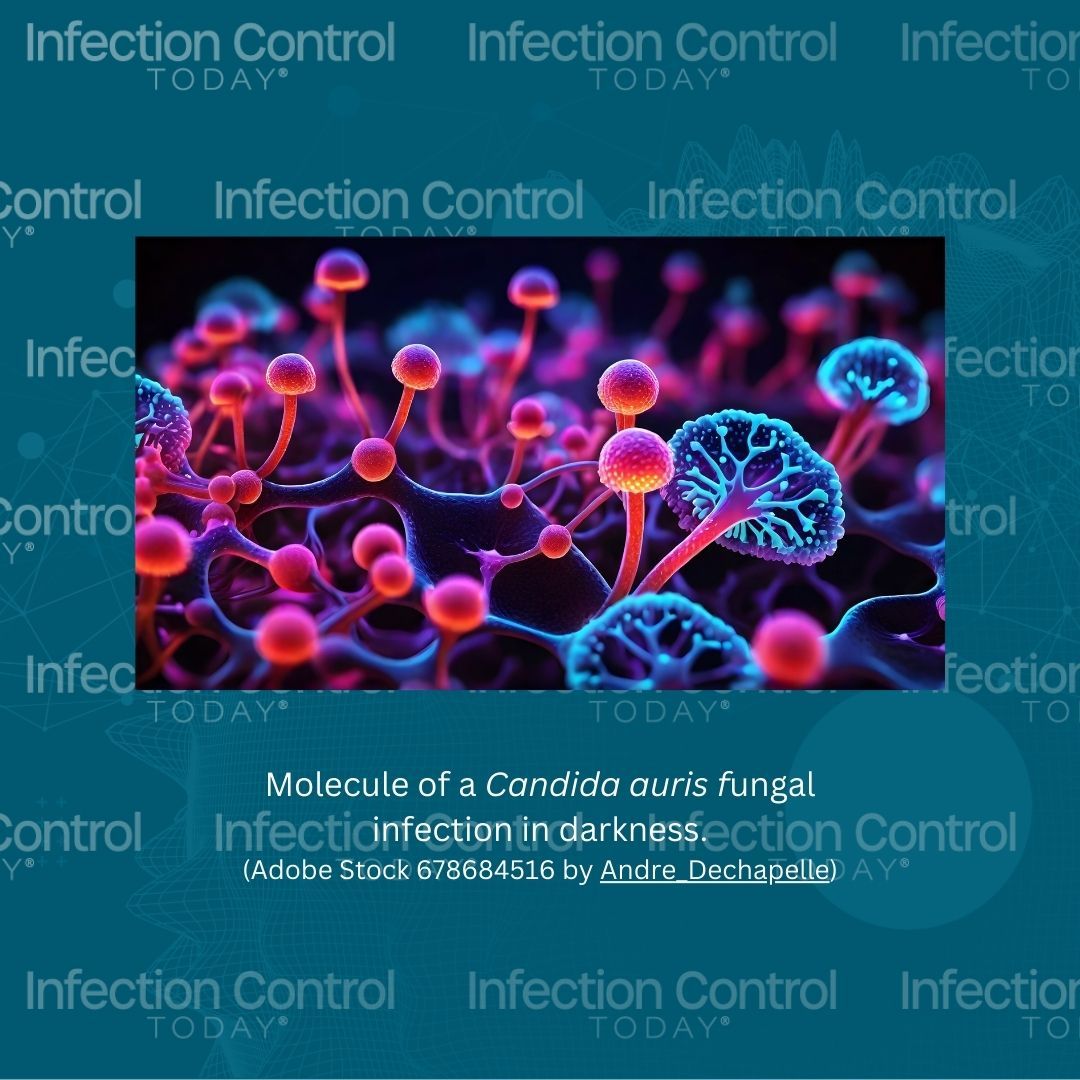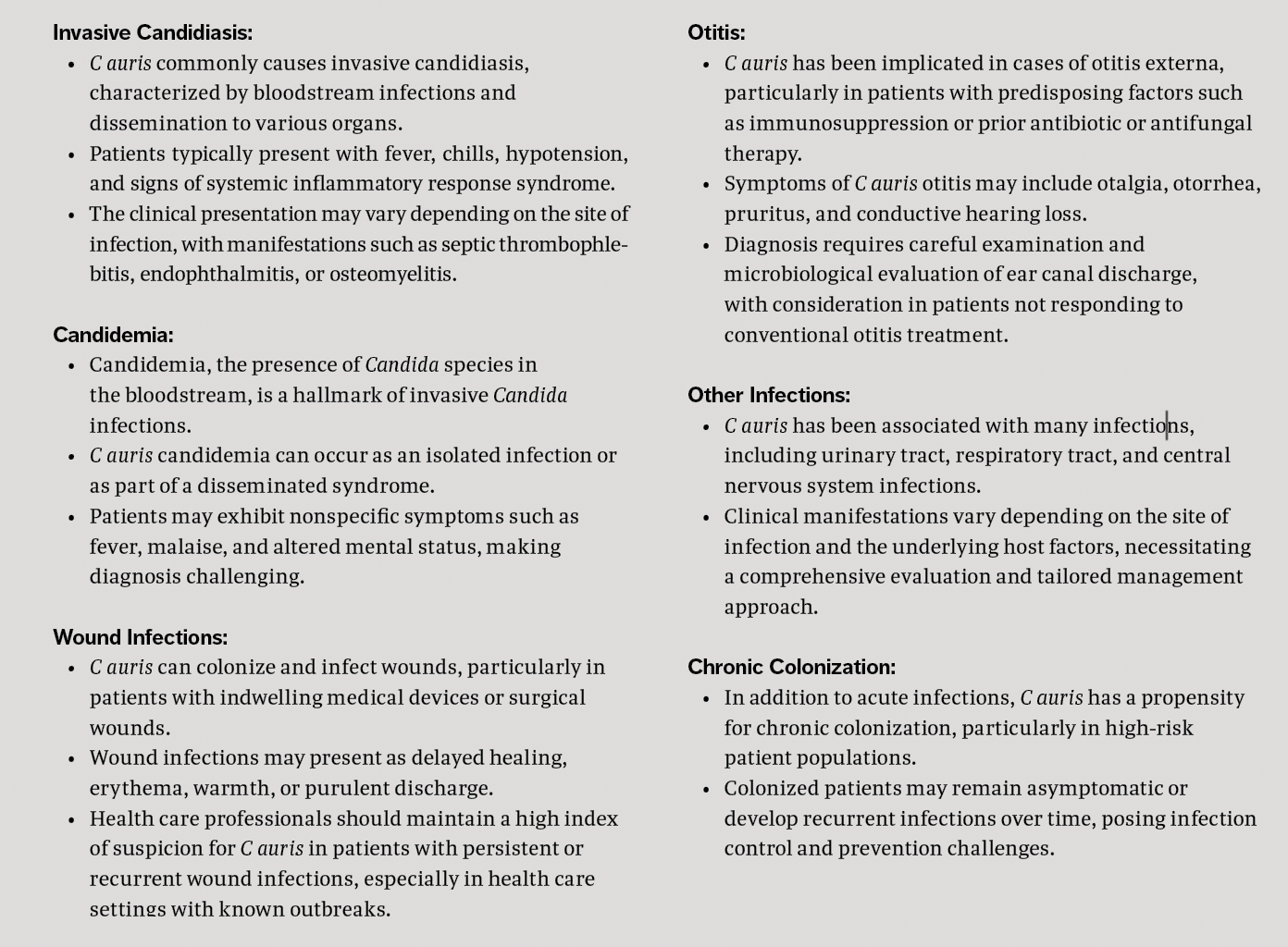The Latest on Candida auris: Updates, Challenges, and Prevention Strategies
Stay informed on the growing threat of Candida auris with expert insights on its multidrug-resistance, clinical manifestations, and effective prevention strategies for health care settings.
Molecule of candida auris fungal infection in darkness.
(Adobe Stock 678684516 by Andre_Dechapelle)

The rising prevalence of immunocompromised individuals has made Candida auris a significant concern in critical care medicine due to its resistance to treatment and its association with candidiasis, the most common cause of fungal infections. Every year, fungal pathogens such as C auris cause at least 13 million illnesses and 1.5 million fatalities worldwide.1 In individuals with impaired immune systems, infections can escalate rapidly, leading to wound infections, otitis externa, and candidemia, which can cause significant morbidity and death rates.1
Health care–associated infections (HAIs) pose a significant challenge in clinical settings worldwide. The risk of contracting HAIs is 20 times higher in developing countries than in developed countries.2 Among these, C auris has emerged as a concerning pathogen due to its multidrug resistance and ability to cause outbreaks in health care facilities, including long-term care facilities. It exhibits multidrug resistance patterns to typical antifungal medication used for other intrusive Candida infections and a host of additional virulence factors.3 This article aims to provide health care professionals with the latest updates on C auris infections, including epidemiology, risk factors, clinical manifestations, diagnosis, treatment options, and prevention strategies.
Recent Updates: C auris is growing alarmingly throughout US health care institutions and is deemed an “urgent antimicrobial resistance threat,” according to a March 20, 2023, warning from the CDC.4 Since the first clinical case of C auris was reported in the US in 2016 (n = 13 cases), the number of cases has grown annually.4 Clinical cases climbed from 476 in 2019 to 1471 in 2021; the volume of colonization screening cases grew by 80%, and the number of screening cases increased by almost 200% in 2021. Between January and December of 2022, the most current 12-month period, 2377 clinical cases were documented.5
The CDC points out several factors, such as inadequate general infection prevention and control in health care institutions, might have contributed to the rise in case counts.6 The COVID-19 burden on hospital and public health systems, however, may have exacerbated the spread of the fungus given the precise moment of the surge.7
Risk Factors: Patients at highest risk of C auris infection include those with prolonged hospital stays; exposure to broad-spectrum antibiotics or antifungal agents; invasive procedures; and underlying medical conditions such as diabetes, immunosuppression, or indwelling devices. Additionally, health care workers may inadvertently contribute to the spread of C auris through poor hand hygiene practices or inadequate environmental cleaning.
Clinical Manifestations: C auris primarily affects patients with compromised immune systems and can lead to bloodstream infections, wound infections, and invasive candidiasis. Clinical manifestations vary but may include fever, chills, hypotension, and localized signs of infection.8
C auris infections present myriad clinical manifestations that can range from subtle to severe, posing diagnostic challenges for health care professionals. Understanding the diverse ways in which this pathogen manifests is crucial for timely recognition and appropriate management.
Here is the clinical spectrum of C auris infections Table:
Table: Here is the clinical spectrum of C auris infections:

1. Invasive Candidiasis:
- C auris commonly causes invasive candidiasis, characterized by bloodstream infections and dissemination to various organs.
- Patients typically present with fever, chills, hypotension, and signs of systemic inflammatory response syndrome.
- The clinical presentation may vary depending on the site of infection, with manifestations such as septic thrombophlebitis, endophthalmitis, or osteomyelitis.
2. Candidemia:
- Candidemia, the presence of Candida species in the bloodstream, is a hallmark of invasive Candida infections.
- C auris candidemia can occur as an isolated infection or as part of a disseminated syndrome.
- Patients may exhibit nonspecific symptoms such as fever, malaise, and altered mental status, making diagnosis challenging.
3. Wound Infections:
- C auris can colonize and infect wounds, particularly in patients with indwelling medical devices or surgical wounds.
- Wound infections may present as delayed healing, erythema, warmth, or purulent discharge.
- Health care professionals should maintain a high index of suspicion for C auris in patients with persistent or recurrent wound infections, especially in health care settings with known outbreaks.
4. Otitis:
- C auris has been implicated in cases of otitis externa, particularly in patients with predisposing factors such as immunosuppression or prior antibiotic or antifungal therapy.
- Symptoms of C auris otitis may include otalgia, otorrhea, pruritus, and conductive hearing loss.
- Diagnosis requires careful examination and microbiological evaluation of ear canal discharge, with consideration in patients not responding to conventional otitis treatment.
5. Other Infections:
- C auris has been associated with many infections, including urinary tract, respiratory tract, and central nervous system infections.
- Clinical manifestations vary depending on the site of infection and the underlying host factors, necessitating a comprehensive evaluation and tailored management approach.
6. Chronic Colonization:
- In addition to acute infections, C auris has a propensity for chronic colonization, particularly in high-risk patient populations.
- Colonized patients may remain asymptomatic or develop recurrent infections over time, posing infection control and prevention challenges.
Diagnosis: Laboratory diagnosis of C auris infections can be challenging due to its similarity to other Candida spp and the limitations of conventional diagnostic methods. Molecular techniques such as polymerase chain reaction assays and matrix-assisted laser desorption/ionization time-of-flight mass spectrometry have improved the accuracy and speed of identification.8 Furthermore, health care facilities should establish surveillance programs to monitor the prevalence of C auris and detect outbreaks early.
Treatment Options: The effective management of C auris infections necessitates a collaborative effort involving infectious disease specialists, microbiologists, and pharmacists. Antifungal susceptibility testing should inform the selection of appropriate therapy, considering local epidemiology and resistance patterns. C auris exhibits a notable propensity for treatment resistance; a considerable portion of isolates display resistance to fluconazole, with over half demonstrating resistance to 2 or more antifungal agents. Despite this challenge, certain strains of C auris retain susceptibility to echinocandins, polyenes, and occasionally azoles.
On March 22, 2023, the FDA granted authorization for rezafungin, an antifungal medication, for the treatment of invasive candidiasis and candidemia.3 Furthermore, clinical trials for fosmanogepix and ibrexafungerp have progressed to phase 3, indicating potential future options for combating C auris infections.3 In refractory cases, combination therapy and higher doses may be warranted to enhance treatment efficacy.
Prevention Strategies: Preventing the transmission of C auris within health care facilities is paramount in controlling outbreaks.9
- Isolation: Patients with C auris should be isolated with standard hygiene measures, such as gloves, cover gowns, hand sanitizers, and specialized equipment.10 When using equipment on a different patient, it must be cleaned and sterilized if it cannot be dedicated. Complete cessation of reusable equipment may be required in a continuing transmission. Moving around the room and facility should be restricted for patients to maintain appropriate contact precautions and environmental cleanliness. The CDC advises continuing isolation and contact restrictions if an individual has a C auris colony.6 Although the exact length of colonization is unknown, it is thought to have been protracted and unending. Patients who must be transferred between institutions require careful planning and coordination between the sending and receiving facilities. Departments specializing in infection prevention and control can help ensure that infection control procedures are followed before and after transfer.
- Cleaning and Disinfection: Maintaining and stopping the spread of C auris is essential by cleaning and disinfecting shared mobile equipment and the surrounding area.10 Patients with colonization or infection with C auris should be cleaned daily and discharged using a disinfectant that specifically targets C auris. The CDC advises using a UV-resistant, US Environmental Protection Agency List K disinfectant. Setting up a plan for environmental cleaning and disinfection should result from cooperation between infection prevention and control and the environmental services department. Every day, all spaces used by patients with C auris should be cleaned and disinfected, paying particular attention to high-touch surfaces. Disposable or specialized equipment is advised for cases of C auris that are confirmed or suspected.11
- Surveillance: Health care institutions that have seen patients with prolonged stays in facilities outside of the US in the preceding year, closely connected patients, and patients in critical condition should all consider screening more patients for C auris colonization to find unidentified cases.12 Because the groin and axilla are the most-colonized locations, a swab of a patient’s bilateral axilla should be used for screening. When a patient is found to be colonized with C auris, infection control procedures should be initiated. Facilities should be aware of circumstances in which the tendency for misidentification makes C auris suspicious.13
Conclusion:
C auris still presents problems for health care providers at all levels. Although research on and clinical experience with C auris have recently increased, many unresolved concerns remain.1 Certain concerns, such as the length of colonization and the necessity of isolation, screening techniques, and the proper cleaning and disinfection of environments, require more investigation.
C auris represents a formidable challenge in the fight against HAIs, necessitating vigilant surveillance, prompt diagnosis, and appropriate management. By staying informed about the latest updates on C auris, health care professionals can effectively mitigate its impact on patient outcomes and public health.
References
1. Cristina ML, Spagnolo AM, Sartini M, et al. An overview on Candida auris in healthcare settings. J Fungi (Basel). 2023;9(9):913. doi:10.3390/jof9090913
2. Li RJ, Wu YL, Huang K, et al. A prospective surveillance study of healthcare-associated infections in an intensive care unit from a tertiary care teaching hospital from 2012-2019. Medicine (Baltimore). 2023;102(31):e34469. doi:10.1097/MD.0000000000034469
3. Wang S, Pan J, Gu L, et al. Review of treatment options for a multidrug-resistant fungus: Candida auris. Med Mycol. 2024;62(1):myad127. doi:10.1093/mmy/myad127
4. Alshahrani FS, Elgujja AA, Alsubaie S, et al. Description of Candida auris occurrence in a tertiary health institution in Riyadh, Saudi Arabia. Healthcare (Basel). 2023;11(24):3150. doi:10.3390/healthcare11243150
5. Lyman M, Forsberg K, Sexton DJ, et al. Worsening spread of Candida auris in the United States, 2019 to 2021. Ann Intern Med. 2023;176(4):489-495. doi:10.7326/M22-3469
6. Yune PS, Coe J, Rao M, Lin MY. Candida auris in skilled nursing facilities. Ther Adv Infect Dis. 2023;10:20499361231189958. doi:10.1177/20499361231189958
7. Saifullah, Ma Z, Li M, Maqbool MQ. Impact of COVID-19 pandemic on health care workers (HCWs) in Sindh Province of Pakistan. Health Res Policy Syst. 2023;21(1):78. doi:10.1186/s12961-023-01022-5
8. Gupta A, Agarwal J, Singh V, Das A, Sen M. Matrix-assisted laser desorption ionization time of flight (MALDI-TOF) as an indispensable tool in diagnostic bacteriology: a comparative analysis with conventional technique. Cureus. 2023;15(3):e36984. doi:10.7759/cureus.36984
9. Omardien S, Teska P. Skin and hard surface disinfection against Candida auris – what we know today. Front Med (Lausanne). 2024;11:1312929. doi:10.3389/fmed.2024.1312929
10. Infection prevention and control for Candida auris. CDC. Updated January 17, 2023. Accessed February 20, 2024. https://www.cdc.gov/fungal/candida-auris/c-auris-infection-control.html
11. Guidance for the efficacy evaluation of products for claims against drug-resistant Candida auris. US Environmental Protection Agency. Updated October 5, 2023. Accessed February 20, 2024. https://www.epa.gov/pesticide-registration/guidance-efficacy-evaluation-products-claims-against-drug-resistant-candida
12. Screening for Candida auris colonization in healthcare settings. CDC. Updated February 20, 2024. Accessed February 20, 2024. https://www.cdc.gov/fungal/candida-auris/c-auris-screening.html
13. Ahmad S, Asadzadeh M. Strategies to prevent transmission of Candida auris in healthcare settings. Curr Fungal Infect Rep. 2023;17(1):36-48. doi:10.1007/s12281-023-00451-7
Optimizing Drying for Medical Devices: Insights and Strategies From Cheri Ackert-Burr, DNP
April 29th 2024Cheri Ackert-Burr, DNP, BAEd, RN, CNOR, CNS, AGTS, discusses optimizing drying strategies for medical devices, crucial in instrument processing, emphasizing efficiency gains and insights shared at the HSPA Annual Conference.